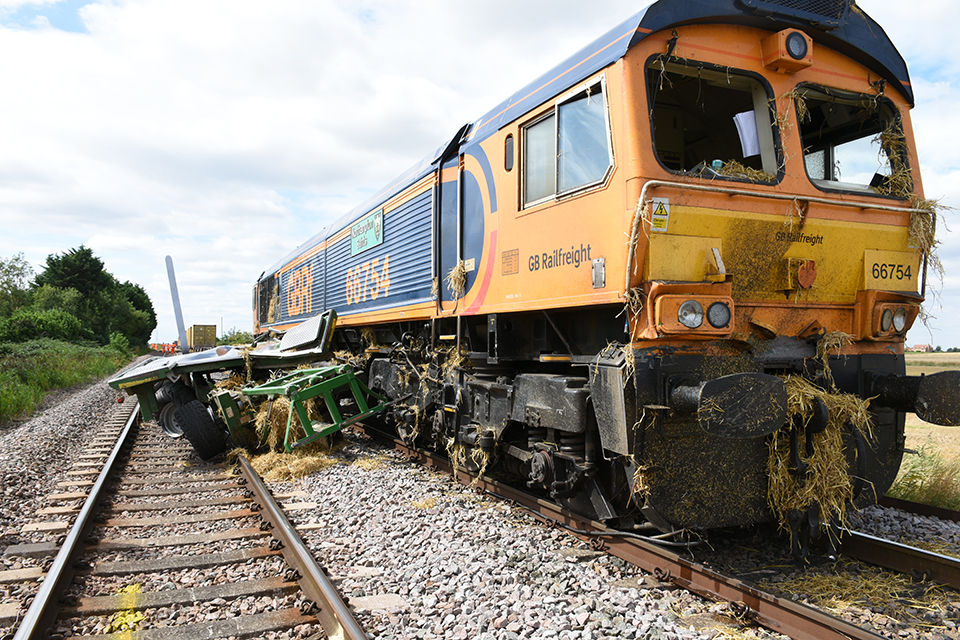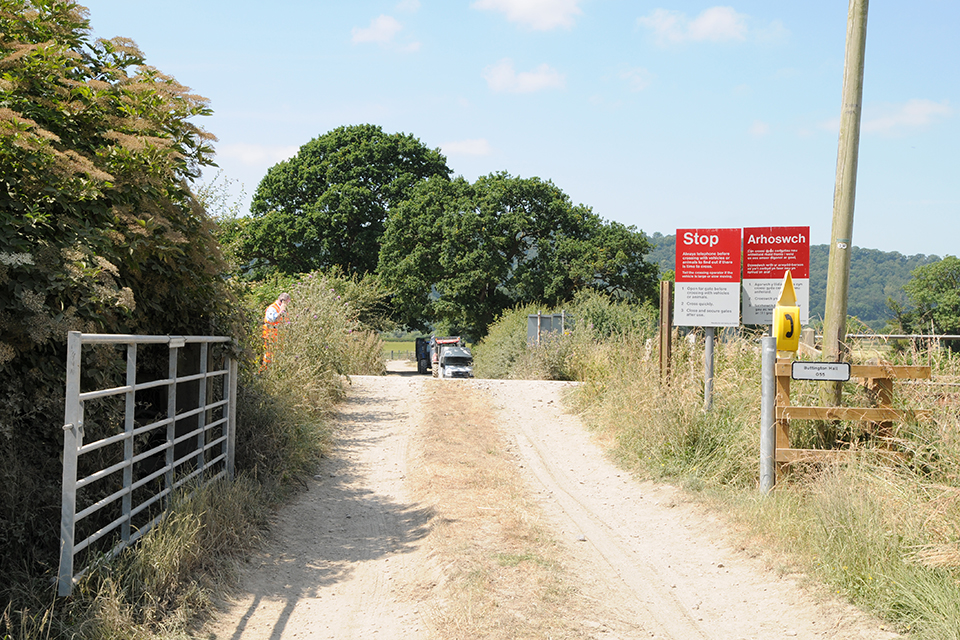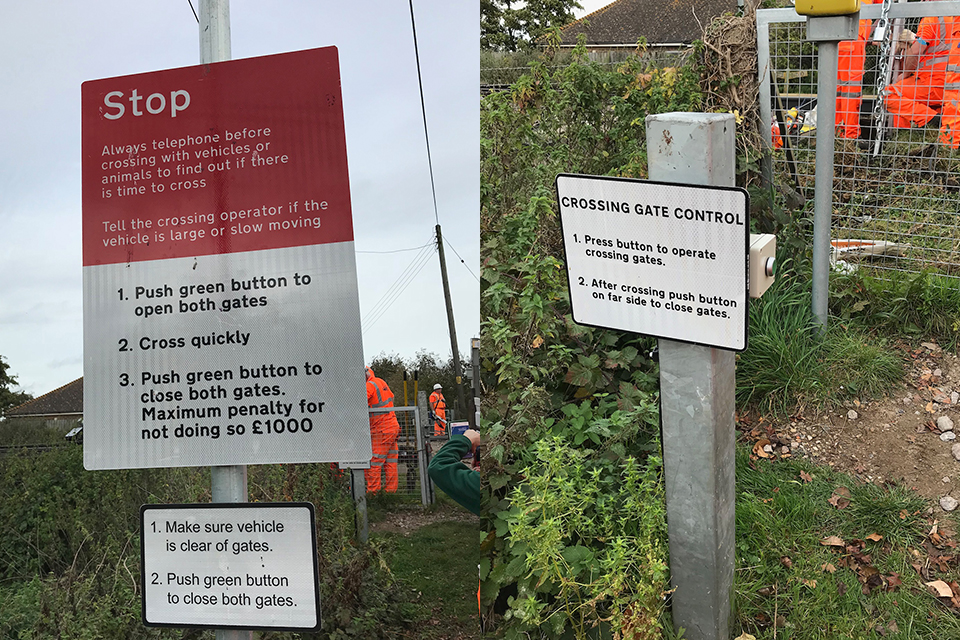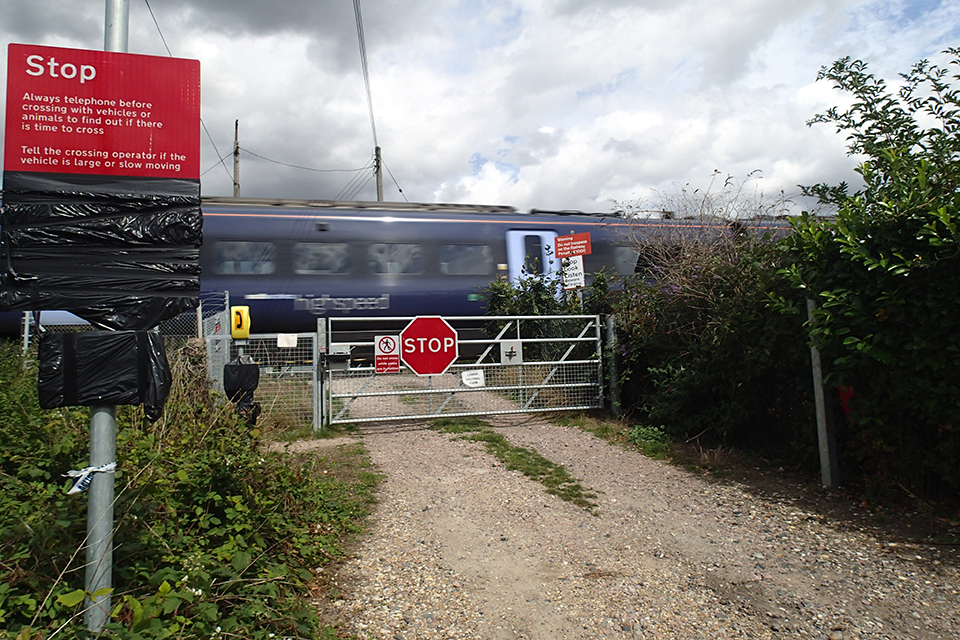Summary of learning - 1. Design and operation of user worked level crossings - v5. May 2024
Published 2 April 2020
1. Purpose of this summary
The purpose of this document is to provide a repository of some of the most important areas of learning identified in RAIB’s investigations to date, cross-referenced to relevant reports. It therefore provides a reference source for those looking to understand real-world railway safety issues and potential control measures.
When preparing this document, RAIB has selected those issues which:
- have recurred in different RAIB investigations
- have still to be fully addressed
- could be a factor in the cause of a fatal accident
RAIB is aware that many of the issues raised have already been the subject of actions by duty holders when responding to RAIB recommendations or are in the process of being addressed. The inclusion of a topic in this document should not be taken to mean that no action has been taken in response to relevant recommendations. However, its inclusion indicates that RAIB is of the view that the issue still needs to be actively managed by duty holders.
The current status of each recommendation made by RAIB can be checked by reference to the Index of RAIB recommendations, and details of the actions taken are published by ORR.
It is not the purpose of this document to quantify the risk associated with each of the identified safety issues. Readers seeking to understand the overall risk of harm associated with various dangerous events should refer to RSSB’s Annual Safety Performance Report. This presents historical information on actual harm caused and estimates of risk based on extensive modelling.
2. Overview
Where road and rail intersect, there is always the potential for accidents. If the level crossing, a legacy of nineteenth-century railway builders, can be closed and replaced by a bridge or underpass, almost all the risk can be eliminated. However, that is not always possible and there are still around 5,800 level crossings on the UK national network, of which about 1,500 are public road crossings.
RAIB has published 79 reports concerning accidents and near misses at level crossings. Level crossings represent about 6% of the total system risk on the GB mainline railway (Rail Safety and Standards Board Annual Health and Safety Report 2022/2023), but the investigations that RAIB has carried out have been over 16% of our work.
There are around 2100 user worked crossings (UWC) on the GB national network (RSSB 2021). Of these 1541 are equipped with telephones and 195 with miniature stop lights.
Many of RAIB’s level crossing investigations (22 of 79) have involved user worked crossings on private roads, where the user must either make their own decision on whether it is safe to cross, or obey instructions given by the rail operator, over the telephone or via steady red/green lights.

The aftermath of the collision at Kisby crossing in 2021.
Where private roads, which lead to houses, farms or other commercial premises, cross the railway on the level, it is normally necessary for crossing users to operate the crossing gates or barriers themselves. In many cases, it is not possible to get sufficient warning of approaching trains by looking along the line, and telephones are provided for users to contact the railway signaller to obtain permission to cross.

A user worked level crossing in Wales. Gates being left open is a regular problem at some crossings.
When someone with a vehicle wants to use a crossing, the signaller may give them permission to cross, if there is sufficient time for the user to do so before the next train will arrive at the crossing. In some circumstances, such as when the user has a slow vehicle or a number of animals, the signaller will stop any trains approaching the crossing until the user has reported that they have crossed over safely and are clear of the line.
Each crossing is provided with signs explaining how to use it. To supplement the signs, the authorised users, who have legal rights to pass along the road or track over the crossing, are given information by the railway about how to use the crossing. They should make arrangements, as far as possible, to pass this information on to their employees and other people who may have to visit the premises served by the crossing.
Most members of the public are unfamiliar with this type of level crossing, and it may not be possible for authorised users to brief people such as delivery drivers before they encounter the crossing for the first time. Safety in such circumstances relies firstly on the user understanding the signs and contacting the signaller before going over the crossing, and then acting on the information given to them. It is also vital that the signaller has adequate information available to assist them to make the correct decision when they are asked for permission to cross.
In 2022, RAIB published an investigation into a near miss at Coltishall in Norfolk on a user worked crossing on a public road, a category of crossing which had not previously featured in our work. There are particular risks with motorists encountering this type of crossing on public roads because most of them are unlikely to be familiar with the concept of a crossing which they must operate themselves.
3. Important areas for safety learning
The areas of significant concern to RAIB fall into the five main themes described below.
3.1 Briefing by authorised users
As explained above, the railway operator considers that the authorised user, who is the person (individual or corporate) with rights of access over the crossing, is responsible for ensuring that people who have to pass over the crossing to visit them are given any necessary information about how to use the crossing. If the authorised user is a company, this duty is emphasised by the company’s obligations under health and safety law to ensure that the risks arising from their undertaking are minimised so far as is reasonably practicable. However, many authorised users are private individuals, and it has become increasingly apparent that in many cases it is not possible for them to brief the whole range of people who may have to use the crossing. This is likely to include delivery drivers, employees of utility companies, carers and other mobile tradespeople. We have therefore recommended, initially in our class investigation into safety of this type of crossing (report 13/2009) and more recently in our report into the accident at Frognal Farm crossing, Kent, in 2017 (report 12/2018), that Network Rail should review the role and duties of the authorised user, and focus on informing each individual user, by the best possible means, how to cross safely each time they approach the crossing.
The 2022 collision at a user worked crossing at Kisby in Cambridgeshire between a freight train and agricultural machinery (report 12/2022) took place on a private road and caused substantial damage as well as derailing the train involved. It occurred after an unfamiliar user did not contact the signaller for permission to cross, as was required for the safe operation of the crossing.
RAIB’s report into the near miss at on a public road at Coltishall crossing (report 03/2022) noted that the concept of authorised users, however effective it may or may not be, in reality can only apply to user worked crossings on private roads.
3.2 Signs
In November 2023, the Private Crossings (Signs and Barriers) Regulations 2023 came into force, bringing into use new designs of warning signs and information boards for UWCs. These replaced the previous signs specified and described in earlier legislation which no longer reflected current thinking on how to convey information, and which could be confusing and hard to understand.
In addition to having a revised design, the new signs include provisions for use with the various novel technologies that have been introduced in recent years, such as power operated gates and barriers. These new regulations have been introduced by the Department for Transport (DfT), working with the industry and the Office of Rail and Road, as a result of RAIB recommendations that called for clear and effective signs to be used at these crossings (report 13/2009 and report 12/2018). UWCs are now being fitted with these new signs, and it is expected that those on the mainline network will have been equipped with them by 2029.

Signs at a user worked crossing.
3.3 Signaller’s judgement
In many cases, crossing users have to telephone a Network Rail signaller to find out whether it is safe to cross. This system places a high degree of reliance on the judgement of the signaller in deciding what to tell the user to do. The information available to the signaller about the position of approaching trains, on which their decision is based, may be limited by the signalling technology in use. The signaller may be supervising a large number of crossings, each with many users each day, and may not have the necessary local knowledge to appreciate the conditions at each one.
We have made recommendations on these issues recently following investigations at Hockham Road, Norfolk, (report 04/2017), Dock Lane, Melton, Suffolk (report 08/2017) and Bagillt (report 11/2019), calling for more use of technology to provide signallers with information on the position of trains, better training for signallers, clearer and more consistent instructions on decision-making, and for Network Rail to better manage factors such as workload and fatigue which may influence signallers’ decisions. The importance of focusing management attention on this risk was demonstrated by an incident at Worlingham, Suffolk in 2020 (safety digest 07/2020).

Damage to the train involved in the collision at Hockham Road in 2016.
3.4 Types of vehicle
Communication between the signaller and the user may not result in a clear understanding of the type of user and how long they need to cross safely. The signaller may have to rely heavily on the road user’s assessment of the time they need to cross, when assessing what sort of protection is required. Following RAIB’s investigation of the dangerous occurrence at Bagillt, Flintshire, in 2018, we have recommended improvements to the communications protocols used by signallers, and clarification of the method of operation when heavy or long road vehicles need to use crossings (report 11/2019).

A large vehicle preparing to go over the user worked crossing at Bagillt.
3.5 Power operated gates
To reduce the problems associated with gates being left open at user worked crossings, and to minimise the number of times people have to cross the track to open and close gates each time they need to use a crossing, Network Rail introduced power operated gate opening (POGO) systems at a number of user worked crossings. These were designed to open the gates when the user pushed a button at the side of the road on the approach to the crossing. The crossings also had either telephones to the signaller, or red/green warning lights, to give information about the approach of trains. The POGO system was not linked to the signalling system, and the gates could be opened at any time, regardless of any approaching trains.
We found in two investigations into collisions (at Oakwood Farm, Yorkshire, in 2015 (report 07/2016) and Frognal Farm, Kent, in 2017 (report 12/2018)) that potential issues with the design had not been sufficiently addressed, and users were likely to assume that if the gates opened in response to a press of the button, it was safe to cross.

Frognal Farm crossing, after removal of the POGO system following the accident in 2017.
RAIB recommended, in both those investigation reports, that Network Rail should review safety at all the crossings fitted with the system and ensure that it properly understands the hazards associated with this type of operating system before any further crossings are converted. Network Rail has taken some POGO systems out of service, and has started a programme of modifications, including linking the operation of the gates to the indication on the stop lights, where these are fitted.
4. Rail industry’s strategic safety groups
Relevant rail industry groups working in this field include the Level Crossing Strategy Group, whose work is described in Network Rail’s document ‘Enhancing Level Crossing Safety 2019 – 2029 A long-term strategy targeting improved safety on Great Britain’s railway’. This includes a suite of new and enhanced measures for passive and telephone crossings.
5. Relevant RAIB publications
- Class investigation into safety at user worked crossings (report 13/2009)
- Fatal accident at Wraysholme crossing, Cumbria (report 26/2009)
- Fatal accident at Halkirk level crossing, Caithness (report 16/2010)
- Class investigation into safety at AOCLs (report 12/2011)
- Collision at Oakwood Farm UWC, near Knaresborough (report 07/2016)
- Collision at Hockham Road UWC, near Thetford (report 04/2017)
- Near miss at Dock Lane UWC, Melton, Suffolk (report 08/2017)
- Collision at Frognal Farm UWC, Kent (report 12/2018)
- Dangerous occurrence at Bagillt UWC, Flintshire, North Wales (report 11/2019)
- Class investigation into factors affecting safety-critical human performance in signalling operations on the national network (report 03/2020)
- Near miss at Worlingham user worked crossing, Suffolk, 8 June 2020 (safety digest 07/2020)
- Near miss at Coltishall user worked crossing, Norfolk, 21 January 2021 (report 03/2022)
- Collision between a train and agricultural equipment at Kisby user worked crossing, Cambridgeshire 19 August 2021 (report 12/2022)

